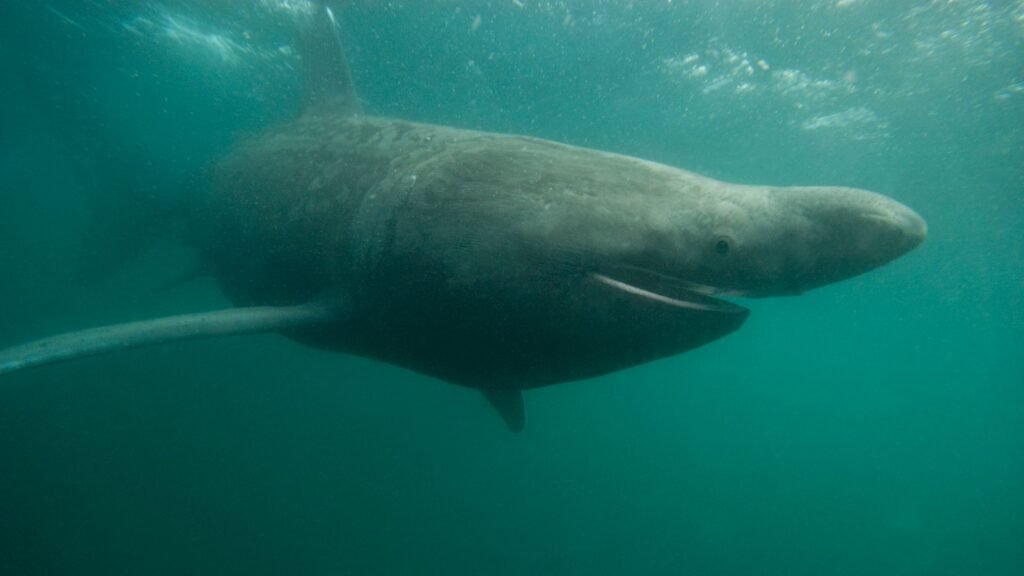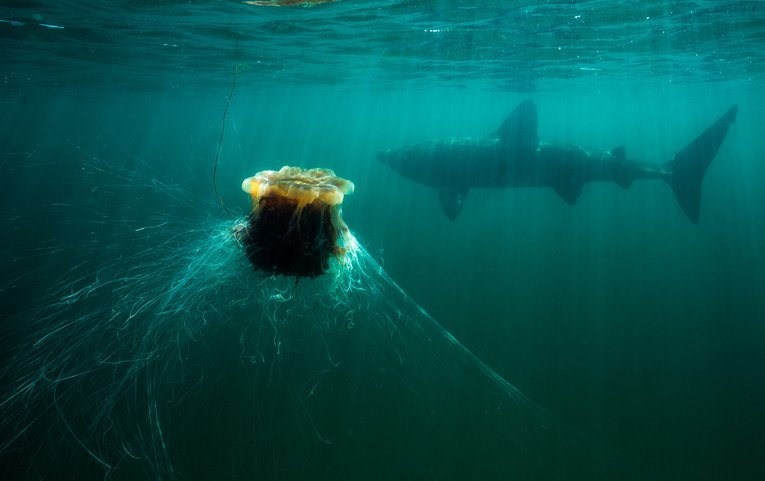Sharks in UK waters could soon become a more common sight as rising ocean temperatures transform marine ecosystems around the British Isles. Warmer seas are driving a shift in species’ geographical ranges, creating new opportunities for some animals while threatening others. Marine scientists now predict that endangered sharks, rays, and even long-suffering native oysters may find new chances to thrive in the UK’s evolving marine habitats.

While the possibility of growth for some species presents an optimistic outlook, others—such as the ocean quahog, a centuries-old clam—may struggle to survive in the changing conditions. The ecological balance of UK waters is poised for a transformation that will affect both marine biodiversity and human communities dependent on the sea.
Sharks in UK Waters and the Climate-Driven Shift of Marine Species
Rising ocean temperatures are already influencing the distribution of marine life. Sharks in UK waters are among the most notable examples of this trend, with several endangered species expanding their range northward. Researchers from the Centre for Environment, Fisheries and Aquaculture Science (Cefas) have created the first comprehensive projection model mapping how 19 vulnerable marine species may respond to environmental changes in UK waters over the next few decades.
By comparing future ocean conditions—based on temperature, salinity, and sediment changes—with the known habitat preferences of these species, scientists aim to understand which animals might adapt, migrate, or vanish. Many mobile species, including sharks in UK waters, are expected to shift their habitats northward, particularly toward the North Sea, which could become a new biodiversity hotspot by 2060.
Warming Seas Fuel Habitat Changes for Sharks in UK Waters
The seas surrounding the UK are warming at an alarming rate—faster than in most other parts of the world. Over the last 50 years, these waters have seen some of the most dramatic temperature rises globally, ranking among the top 20 fastest-warming marine regions. During recent marine heatwaves, surface temperatures in certain areas soared up to 4°C higher than the seasonal average.
This intensifying heat is primarily due to the ocean absorbing more than 90% of the excess energy produced by human-driven fossil fuel emissions. The consequences are already evident, as marine ecosystems shift and species are forced to adapt or relocate. This includes a growing number of sharks in UK waters, which are now seeking out these warmer environments as potential new habitats.
Sharks in UK Waters and Native Oysters Thrive in Warming Seas
Among the species poised to benefit from these environmental shifts are native oysters, basking sharks, thornback rays, and spurdog sharks.
Native oysters, which have seen dramatic population declines due to overharvesting and pollution for over a century, are unexpectedly identified as potential beneficiaries of warming waters. These bivalves could expand into areas previously too cold for sustained survival.

Basking sharks, the world’s second-largest fish, and spurdog sharks, which grow to 1.6 meters in length, are also expected to discover new, more suitable habitats. The thornback ray, a spiny species of skate, is another mobile creature expected to adapt well to climate shifts.
Mobile species, with their ability to travel long distances and seek favorable environments, have a clear survival advantage.
Beyond Sharks in UK Waters: Sea Pens and Ocean Quahogs at Risk
Not all species will thrive. Those with limited mobility, or specific habitat needs, may find themselves at a disadvantage.
One example is the sea pen, a reef-building animal critical to benthic ecosystems. This species could lose up to 40% of its suitable habitat by 2100. Sea pens support a variety of marine life by forming complex underwater structures, so their decline could trigger cascading ecological effects.
Another vulnerable species is the ocean quahog, a deep-sea clam known to live more than 500 years, making it the longest-living non-colonial animal on Earth. Despite its hardiness, it may struggle to cope with rapidly changing temperatures and sediment conditions.
Implications for Marine Ecosystems and Food Chains
Shifting species distributions will have significant consequences beyond individual survival. Changes in population densities, competition for food, and predator-prey relationships could reshape entire ecosystems.
If reef-building species like sea pens disappear, the habitats they create may vanish, leaving dependent species homeless. The decline of ocean quahogs could affect nutrient cycles, while an influx of predators like sharks and rays could change the dynamic of smaller fish populations.
Human Impact: Fisheries, Coastal Communities, and Conservation
Coastal communities, particularly those in the North Sea region, may see changes in fishery yields due to shifting species patterns. Warmer waters could bring new fishing opportunities, such as Mediterranean species previously unknown in UK waters. However, traditional stocks may decline or migrate, affecting livelihoods dependent on those species.

These transitions pose both economic risks and opportunities. For example, the presence of more commercially viable species such as rays and certain shark types might boost catch volumes, but only if managed sustainably.
Protecting the Future: The Role of Marine Protected Areas
Marine Protected Areas (MPAs) are designated zones established to preserve biodiversity by limiting human activities like fishing and drilling. But as marine species move in response to climate shifts, MPAs must also adapt.
The current locations of MPAs may not coincide with future biodiversity hotspots. Scientists suggest that a dynamic approach to conservation is needed—one that considers climate projections and species mobility.
Policy-makers must ensure that protection follows the species, not just the geography. This could involve expanding MPAs, adjusting their boundaries, or creating flexible, migratory corridors for marine life.
Climate Models: Two Visions for 2060
The Cefas study used two sets of projections for the UK marine environment through 2060. These included varying levels of ocean temperature rise, salinity shifts, and changes to seabed sediment composition.
By comparing these models to known ecological requirements of 19 vulnerable species, scientists could predict how each species might fare under different climate scenarios. The study’s findings, published in Marine Biology, represent a significant advancement in forecasting climate impacts on marine ecosystems.
Surprising Discoveries: Oysters Making a Comeback?
One of the most unexpected results from the study was the outlook for native oysters. Long considered a declining species due to overfishing, habitat destruction, and disease, they now appear to have a chance at resurgence.
The models indicate that climate change could actually expand their suitable habitats. However, scientists caution that this doesn’t guarantee a population boom. Without active protection against ongoing threats like pollution and invasive species, oysters could still struggle to recover fully.
Additional Threats: Pollution, Fishing Gear, and Disease
While warming seas may offer new habitats, the success of these marine species also depends on the mitigation of other threats. Bottom-trawling, industrial pollution, plastic waste, and disease continue to jeopardize marine life, regardless of climate advantages.
For oysters, fishing gear and seabed disturbance can destroy habitats before they have a chance to rebound. For sharks and rays, bycatch (accidental capture in fishing nets) remains a persistent issue.
Reducing these stressors through improved marine management is essential for capitalizing on the opportunities presented by shifting environments.
Future of UK Marine Biodiversity: Uncertain But Manageable
The redistribution of marine life in UK waters presents both challenges and hope. While some species will adapt or even flourish, others may vanish from British seas altogether. However, with proactive marine management and climate-resilient conservation strategies, it is possible to protect and even enhance marine biodiversity.
Understanding species migration and ecosystem interdependencies is crucial. Scientists stress the importance of adaptive governance and long-term monitoring to ensure that policy keeps pace with environmental change.
What This Means for Everyday People
For recreational sea users—like swimmers, divers, and anglers—the changing marine environment may become more noticeable. Reports of jellyfish blooms, sightings of previously rare fish, and changing catch compositions are likely to become more common.
For consumers, the types of seafood available in local markets may change, with new options replacing long-familiar species. Environmental awareness and support for sustainable fisheries will become even more important.
Global Lessons from UK Waters
The UK’s experiences offer a valuable model for other island and coastal nations facing similar marine climate impacts. By investing in adaptive research and policy, countries can better understand and manage how warming seas affect local and global biodiversity.

As the UK navigates its changing marine future, it must also contribute to international collaboration on climate resilience, conservation, and marine science.
Warmer Waters Bring New Risks and Rewards
The forecasted boom in sharks, rays, and oysters in warmer UK waters illustrates both the complexity and opportunity presented by climate change. Species are already adapting, and ecosystems are shifting. The question is not whether change will happen—but how society responds to protect marine life in this new reality.
Through adaptive conservation, smarter fisheries management, and informed public engagement, the UK can build a future where both marine biodiversity and human communities flourish side by side.




